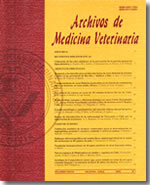Frequency of canine leptospirosis in dogs attending veterinary practices determined through microscopic agglutination test and comparison with isolation and immunofluorescence techniques
Main Article Content
Abstract
The aim of this study was to determine the frequency of leptospirosis in 400 dogs from rural and urban areas that attended veterinary practices in Valdivia (Chile), using the Microscopic Agglutination Test (MAT). Each serum sample was tested against eight serovars of leptospira (hardjo, pomona, canicola, ballum, icterohaemorrhagiae, tarassovi, grippotyphosa, autumnalis), 14.8% of the dogs showed a positive leptospirosis title with the majority of them reacting to the serovars canicola, icterohaemorrhagiae and ballum. Most of these sera had titles between 1/400 and > 1/1600. The results presented in this study do not show a significant difference in relation to gender, origin (urban/rural), breed or vaccination status. A relationship was found between the state of dogs living in the wild and the probability of contracting the disease and vaccinated dogs in relation to the infection with the serovar ballum, being much more likely for vaccinated dogs to contract an infection with this serovar than it is for unvaccinated dogs. Additionally, the study compared the MAT, isolation and indirect immunofluorescence (IFl) techniques using renal tissue of 50 urban dogs. For the IFl study, hyperimmuneserum was obtained from rats inoculated with the serovars canicola and icterohaemorrhagiae. Isolation from renal tissue was unsuccessful, although 14% showed a positive response to MAT and 10% were positively identified with IFL The hyperimmuneserum used in the IFl technique was not serovar specific. The Microscopic Agglutination Test showed a higher sensibility and specificity compared to the isolation and indirect immunofluorescence techniques.

